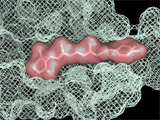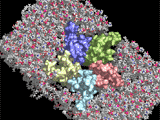
Chem 162A/262A
Drug Design

 |
Chem 162A/262A |
 |
Dr. Kalju Kahn
Office: PSB-N 2623
Office hours: Tue 12:30-1:30 PM, and Thu 12:30-1:30 PM
Phone: 893-6157
E-mail: kalju@chem.ucsb.edu
Website: http://www.chem.ucsb.edu
Robert Levenson
Office: Chem 1317
Phone: 893-5468
E-mail: rlevenson@chem.ucsb.edu
To teach principles that govern the process of modern drug discovery and development. Students in the course follow a path similar to that taken by real-life drug developers by learning important elements of the drug design process in a logical order. Chem 162A, the first in the two-course series focuses on principles of rational drug design. Topics covered include target identification and validation technologies, generation and screening of chemical libraries for finding lead compounds, and modern medicinal chemistry approaches for ligand-based lead optimization. We will cover membrane-bound ion-channels and receptor proteins, and discuss strategies for finding agonists and antagonists for these types of targets.
The second course in the series, Chem 162B, will be taught in the Spring of 2009. The latter course focuses on structure-based drug design. It will outline experimental and computational methods for the study of ligand-protein complexes, and discuss how the knowledge of the three-dimensional structure of the active site helps in the lead optimization process. Chem 162B will also cover approaches used to design competitive and mechanism-based inhibitors based on the mechanistic understanding of enzyme catalysis. Finally, issues of pharmacokinetics and drug metabolism will be dealt with. Students are allowed to take Chem 162B/262B without taking Chem 162A/262B this academic year.
Lecture: MWF 11:00-11:50 Place: Phelps 3505
Computer Lab: Open day access Place: Chem 1153
| Syllabus | General information about the course. | |
| Textbook | The Organic Chemistry of Drug Design and Drug Action by Richard B. Silverman (Second Edition) | Amazon |
| Sample Lecture | Target Validation. (No Password Needed) Warning: Large File | PDF WAV |
| Last Years | Drug Design 162A (by Dr. Kalju Kahn) website for Winter 2009 | Link |
| Last Years | Drug Design 162B (by Dr. Kalju Kahn) website for Spring 2009 | Link |
| Project Tips | Guidelines to Project Development | |
| Exam | Midterm Preparation Guide | |
| Exam Key | Midterm Exam Key (Fall 2009) | |
| Exam | Final Preparation Guide | |
| Exam Sample I | Sample questions with answers from Spring 2004 | |
| Exam Key | Final Exam Key, Fall 2009 | |
| Upload | Submit your assignments as PDF files | Link |
Course notes will be posted here before 7:30 a.m. of the lecture day. The lecture slides are password-protected. Contact your instructor to obtain the password.
| Notes | Lecture Notes. Powerpoint Pages in PDF | Acrobat |
| Sep 25 | Overview of the course. History of Drug Design. | |
| Sep 28 | Rational Drug Design: Overview of Approaches | |
| Sep 30 | Diseases and the Biological Concept | |
| Oct 2 | Target Validation: Principles | |
| Oct 5 | Target Validation: Pre-Genomic Methods | |
| Oct 7 | Target Validation: Post-Genomic Methods | |
| Oct 9 | Target Validation Tutorial | Link |
| Oct 12 | Enzymes as Drug Targets | |
| Oct 16 | Receptors as Drug Targets: Ion Channels | |
| Oct 19 | Receptors as Drug Targets: Ion Channels | |
| Oct 21 | Receptors as Drug Targets: GPCRs | |
| Oct 23 | Study of Membrane Receptors | |
| Oct 28 | Nuclear Hormone Receptors | |
| Oct 30 | Combinatorial Chemistry | |
| Nov 2 | Assays | |
| Nov 4 | Ligand-based drug design and optimization | |
| Nov 6 | Ligand-based drug design and optimization | |
| Nov 9 | Fragment-based drug design and optimization | |
| Nov 16 | QSAR | |
| Nov 23 | Nucleic Acid Drugs | |
| Nov 30 | Job Options, Marketplace, and FDA |
| Literature | Required reading in PDF | Acrobat |
| General | From Serendipity to Rational Drug Design | |
| History | Drug Discovery: A Historical Perspective | |
| Future | Drug Research: Myths, Hype and Reality | |
| General | Antibacterial discover strategy: GSK story | |
| Receptors | Principles: Receptor Theory in Pharmacology (Kenakin, 2004) | |
| Receptors | Epibatidine: Impact on Nicotinic Receptor Research (Dukat & Glennon, 2003) | |
| Receptors | Orphan GPCRs (Wise, Jupe, and Rees, 2004) | |
| Ligand-Based | Chemistry of 1,4-benzodiazepines (Sternbach, 1971) | |
| Ligand-Based | Molecular Superposition (Miller, 1998) | |
| Ligand-Based | Fragment-Based Drug Discovery (Erlanson, 2004) | |
| SBDD | High-throughput docking: thyroid hormone receptor |
Suggested literature can be found now on a separate page
The assignments are posted one week before the due date. Answers shall be submitted electronically no later than the midnight of the due date.
| Assignments | PDF files | Acrobat |
| 1 | Molecular Mechanisms of Diseases. General Principles of Drug Design | |
| 2 | Target Identification via DNA Microarray: Due Oct 16 | |
| 3 | Receptors: general features and ligand design: Due Oct 23 | |
| 4 | Assays and CombiChem: Due Nov 6 | |
| 5 | Ligand-Based Drug Design: Conformation of Neuraminidase Inhibitors | Link |
| 6 | Ligand-Based Drug Design: Descriptors in QSAR | Link |
| 6 | Ligand-Based Drug Design: Statistics in QSAR | Link |
| 6 | QSAR Example 1: Antibacterial Activity of Sulfonamides | |
| 6 | QSAR Example 2: Anesthetic Activity of Barbiturates | |
| 6 | QSAR Example 3: Multiple Linear Regression: Capsaicin | NB |
The assignment keys are typically posted one week after the due date.
| Keys | PDF files | Acrobat |
| 1 | Molecular Mechanisms of Diseases. General Principles of Drug Design | |
| 2 | Statistical Analysis of Microarray Data | |
| 3 | Membrane-bound receptors: Orphan GPCR's | |
| 4 | Assays and CombiChem | |
| 5 | Ligand-Based Drug Design: Conformation of Neuraminidase Inhibitors | |
| 5 | QSAR: Barbituric Acid Analogs |
The project milestone guides are typically posted week and a half before they are due.
Students in this course encounter many terms which have specific meaning in the context of drug design and medicine. You may find our glossary helpful when reading some of the assigned papers. If you encounter a term that is not in this dictionary, you could try a specialized medicinal chemistry glossary at www.chem.qmw.ac.uk/iupac/medchem ,an on-line dictionary at www.dictionary.com or an on-line encyclopedia at www.wikipedia.com . Feel free to send any additions and suggestions to Kalju Kahn
PyMOL Home Page
Biomolecular Images for Teaching with PyMOL
SYBYL Tutorial
Short List of Programs
Modern Drug Discovery
Nature Reviews Drug Discovery
Drug Discovery and Development
Drug Design Lecture Notes by Dr. Hugo Kubinyi
Oxford Drug Resistance Group Lectures
Basic Pharmacokinetics
Calcium Channel Blockers
Brain Chemistry
Acetylcholine Receptor
Online Video-Lectures
Dr. Andrew Boa lecture notes
An Overview of Marine Drug Discovery
Electronic Journals at UCSB
Google Web Search Engine
Biology Workbench
ExPASy Molecular Biology Server
Protein Data Bank
Periodic Table of the Elements
Cell and Molecular Biology Protocols Online
UCSB General Catalog
UCSB Campus Map
UCSB Gold Login
UCSB Umail Access
UCSB Environmental Health and Safety